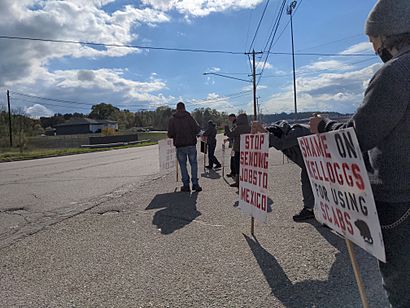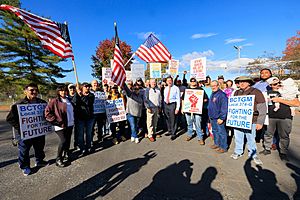2021 Kellogg's strike facts for kids
Quick facts for kids 2021 Kellogg's strike |
|||
|---|---|---|---|
| Part of Striketober | |||

Workers picketing on October 31, 2021 in Battle Creek, Michigan
|
|||
| Date | October 5 – December 21, 2021 | ||
| Location | |||
| Caused by | Disagreements over terms of a new labor contract | ||
| Methods |
|
||
| Parties to the civil conflict | |||
|
|||
The 2021 Kellogg's strike was a work stoppage by about 1,400 employees of the Kellogg Company. It happened from October 5 to December 21, 2021. The workers were members of a group called the Bakery, Confectionery, Tobacco Workers and Grain Millers' International Union (BCTGM).
The strike happened because the union and Kellogg's disagreed on a new work contract. Key issues included pay differences, health care, holidays, and retirement plans. This strike affected all of Kellogg's cereal factories in the United States. These factories are in Battle Creek, Michigan; Omaha, Nebraska; Lancaster, Pennsylvania; and Memphis, Tennessee.
This was the first strike at the Battle Creek plant since 1972. It was also the first at the Lancaster plant since 1985. The strike ended when the workers voted to accept a new five-year contract.
Contents
What Caused the Kellogg's Strike?
Kellogg's is a well-known American food company. A big part of its money comes from breakfast cereals. Some popular brands include Froot Loops and Frosted Flakes. In the U.S., Kellogg's has four main cereal factories. These are located in Battle Creek, Omaha, Lancaster, and Memphis.
The company had been talking with the BCTGM union for over a year. This union represents about 1,400 workers at these factories. The relationship between Kellogg's and the union had been difficult for several years. For example, Kellogg's locked out workers in Memphis in 2013 and 2014. They also fired about 187 workers in Battle Creek in 2018.
In September 2021, Kellogg's announced more job cuts. They planned to fire about 200 more employees from the Battle Creek plant. Most of these would be union members. The old contract between the union and the company was supposed to end in 2020. However, it was extended until October 2021.
Why Workers and Kellogg's Disagreed
In September 2021, both sides shared their ideas for a new contract. But they could not agree on several important points. These included health care, holidays, retirement benefits, and vacation time.
A major disagreement was about a "two-tier" pay system. Under this system, "legacy" employees earned more money. They averaged about $35 per hour. Newer "transitional" employees made less, around $22 per hour. The old contract limited how many workers could be "transitional." Only 30% of employees could be in this lower-paid group.
Kellogg's wanted to remove this limit. The union worried this would mean most workers would be paid less. The union also said Kellogg's threatened to move some production to Mexico. This would happen if the changes were not accepted. A union leader in Omaha, Daniel Osborn, spoke out against this. He worried about food safety if production moved outside U.S. control.
The union also stated that Kellogg's wanted to stop giving raises based on the cost of living. They also wanted to stop offering pensions to new employees. Pensions are like a retirement savings plan.
How the Strike Happened

The strike began early on October 5, 2021. Workers started picketing outside Kellogg's factories. Picketing means standing outside a workplace to protest. All four of Kellogg's U.S. factories stopped working.
Kellogg's said they would use "contingency plans" to keep making products. This meant they would use other employees and outside help. A union member said the company might try to bring in strikebreakers. These are people who work during a strike.
It was unclear if the strike would stop Kellogg's products from reaching stores. The mayor of Battle Creek, Mark Behnke, asked both sides to talk again. A union spokesperson suggested that supporters should not buy Kellogg's cereals. This would help the striking workers. The union said the strike would continue until a new contract was agreed upon.
Key Moments During the Strike
On October 11, temporary workers began arriving at Kellogg's plants. They were there to replace the striking workers. The next day, Kellogg's shared a press release. It tried to explain their side of the story.
A union leader in Omaha suggested workers go back to work for 90 days. This would be under the old contract terms. It would allow time to agree on a new contract. But talks remained stuck.
On October 13, a large rally was held near the Omaha factory. Many people supported the strike. Members of other unions, like the AFL-CIO, also attended. Around this time, a photo of a striking worker in the rain went viral online. Many people shared it and showed support for the strike.
On October 14, several lawmakers from Nebraska supported the strikers. They asked Kellogg's to negotiate fairly. The next day, Newsweek reported that Kellogg's was looking for replacement workers. The ad said these temporary jobs could become permanent.
Proposed Agreement and Its Rejection
On December 2, Kellogg's and the union leaders announced a possible new contract. This five-year agreement would have raised wages by 3% for long-time workers. It would also set standard pay for "transitional" employees. Their starting pay would be $22.76 per hour. They would get a 90-cent raise each year for six years.
The agreement also offered better dental and vision benefits for all workers. Transitional employees would get more vacation time based on how long they worked. However, this contract still kept the two-tier wage system. The union's main goal was to get rid of this system.
On December 5, the union members voted on this proposed agreement. They strongly rejected it. After the vote, on December 7, Kellogg's announced a plan. They said they would try to replace all 1,400 striking workers.
The Strike Comes to an End
On December 21, the Kellogg workers voted again. This time, they approved a new work agreement. This vote ended the strike, which had lasted for 77 days.
Images for kids


